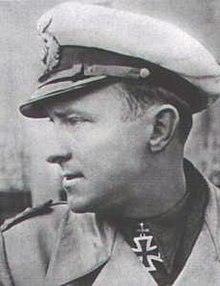Robert Karl Friedrich Gysae (14 January 1911 – 26 April 1989) was a German U-boat commander in the Kriegsmarine during World War II. He was a recipient of the Knight's Cross of the Iron Cross with Oak Leaves of Nazi Germany. Gysae commanded U-98 and U-177, being credited with sinking twenty-five ships on eight patrols, for a total of 146,815 gross register tons (GRT) of Allied shipping.
Robert Gysae | |
|---|---|
 | |
| Born | 14 January 1911 Berlin-Charlottenburg, German Empire |
| Died | 26 April 1989 (aged 78) Wilhelmshaven, West Germany |
| Allegiance | |
| Service | |
| Years of service | 1931–45 1956–70 |
| Rank | Korvettenkapitän (Kriegsmarine), Flottillenadmiral (Bundesmarine) |
| Commands | U-98 U-177 |
| Battles / wars | Battle of the Atlantic |
| Awards | Knight's Cross of the Iron Cross with Oak Leaves |
Career
editGysae joined the Reichsmarine in 1931 and served on torpedo boats before transferring to the U-Bootwaffe ("U-boat force") in April 1940. In October 1940 he was appointed commander of the Type VIIC U-boat U-98, unusually without serving any time as either 1.WO (1. Wachoffizier, "1st Watch Officer") or Kommandantenschüler ("Commander-in-Training") on any other U-boats. After six patrols in the north Atlantic in command of U-98, in March 1942 he transferred to the Type IXD2 U-boat U-177 for another two patrols, this time operating off South Africa and Portuguese East Africa. He sank a total of 25 ships, including the armed merchant cruiser HMS Salopian.
On 28 November 1942 off the coast of Natal Province, Gysae sank the 6,796 ton British troop ship RMS Nova Scotia with three torpedoes. She was carrying 780 Italians; a mixture of prisoners of war and civilian internees. Gysae rescued two survivors to identify the ship, who turned out to be Italian merchant sailors. Mindful of the Laconia Order issued two months previously, Gysae radioed the BdU, who ordered him to continue his patrol. The BdU notified the Portuguese authorities, who sent the frigate NRP Afonso de Albuquerque from Lourenço Marques to help. Of 1,052 people from the Nova Scotia only 194 survived: 192 rescued by the frigate and two others in subsequent days. 858 were killed, including 650 Italians.[1]
In January 1944 he became commander of 25th U-boat Flotilla, a training flotilla based at Gotenhafen. In April 1945, during the last month of the war, Gysae commanded the Marinepanzerjagd-Regiment 1, a naval anti-tank regiment. After the war he served in the German Mine Sweeping Administration (Deutscher Minenräumdienst) for more than two years. In 1956 he joined the Bundesmarine, serving for four years as naval attaché in the United States, and then three years as commander of Marinedivision Nordsee with the rank of Flottillenadmiral before retiring in 1970. He died in 1989 aged 78.[3]
Awards
edit- Wehrmacht Long Service Award 4th Class (2 October 1936)[4]
- The Return of Sudetenland Commemorative Medal of 1 October 1938 (20 December 1939)[5]
- Spanish Cross in Bronze with Swords[6]
- Iron Cross (1939)
- Knight's Cross of the Order of the Crown of Italy (11 March 1941)[5]
- U-boat War Badge (1939) (31 May 1941); with Diamonds[6]
- Croce di Guerra with Swords (Italy, 25 May 1943)[5]
- Wound Badge (1939) in Black (25 June 1943)[5]
- War Merit Cross, 2nd Class with Swords (1 September 1944)[5]
- U-boat Front Clasp in Bronze (1 October 1944)[5]
- Knight's Cross of the Iron Cross with Oak Leaves
- Legion of Merit (United States of America)[6]
- Officer's Cross, Order of Merit of the Federal Republic of Germany[6]
References
editCitations
edit- ^ Helgason, Guðmundur. "Nova Scotia (Troop transport) - Ships hit by U-boats - uboat.net". German U-boats of WWII - uboat.net. Retrieved 5 March 2010.
- ^ Kilian 2011, p. 325.
- ^ Helgason, Guðmundur. "Korvettenkapitän Robert Gysae". German U-boats of WWII - uboat.net. Retrieved 18 April 2010.
- ^ Busch & Röll 2003, p. 182.
- ^ a b c d e f g h Busch & Röll 2003, p. 183.
- ^ a b c d Busch & Röll 2003, p. 184.
- ^ a b Scherzer 2007, p. 356.
Bibliography
edit- Busch, Rainer; Röll, Hans-Joachim (2003). Der U-Boot-Krieg 1939–1945 — Die Ritterkreuzträger der U-Boot-Waffe von September 1939 bis Mai 1945 [The U-Boat War 1939–1945 — The Knight's Cross Bearers of the U-Boat Force from September 1939 to May 1945] (in German). Hamburg, Berlin, Bonn Germany: Verlag E.S. Mittler & Sohn. ISBN 978-3-8132-0515-2.
- Fellgiebel, Walther-Peer [in German] (2000) [1986]. Die Träger des Ritterkreuzes des Eisernen Kreuzes 1939–1945 — Die Inhaber der höchsten Auszeichnung des Zweiten Weltkrieges aller Wehrmachtteile [The Bearers of the Knight's Cross of the Iron Cross 1939–1945 — The Owners of the Highest Award of the Second World War of all Wehrmacht Branches] (in German). Friedberg, Germany: Podzun-Pallas. ISBN 978-3-7909-0284-6.
- Jürgen, Rohwer (1999). Axis submarine successes of World War Two: German, Italian, and Japanese submarine successes, 1939-1945. Greenhill Books. ISBN 978-1557500298.
- Kilian, Dieter E. (2011). Politik und Militär in Deutschland: Die Bundespräsidenten und Bundeskanzler und ihre Beziehung zu Soldatentum und Bundeswehr [Politics and the Military in Germany: The Federal Presidents and Chancellors and their Relationship to Soldiers and the Bundeswehr] (in German). BoD – Books on Demand. ISBN 978-3-937885-36-0.
- Scherzer, Veit (2007). Die Ritterkreuzträger 1939–1945 Die Inhaber des Ritterkreuzes des Eisernen Kreuzes 1939 von Heer, Luftwaffe, Kriegsmarine, Waffen-SS, Volkssturm sowie mit Deutschland verbündeter Streitkräfte nach den Unterlagen des Bundesarchives [The Knight's Cross Bearers 1939–1945 The Holders of the Knight's Cross of the Iron Cross 1939 by Army, Air Force, Navy, Waffen-SS, Volkssturm and Allied Forces with Germany According to the Documents of the Federal Archives] (in German). Jena, Germany: Scherzers Militaer-Verlag. ISBN 978-3-938845-17-2.